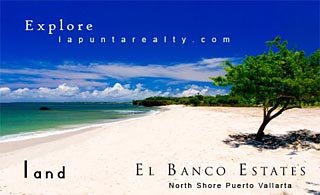Pacific Mexican Renaissance

The coveted coastline of Mexico, now available for foreign investment, is experiencing a luxury development boom.
(PRWEB) April 8, 2005 -- The well kept secrets of Pacific Mexico's dramatic cliffs, coves and sand have long attracted the Hollywood set looking for a quiet escape. Since opening up to foreign investment, Mexico has seen an explosion in luxury residential resort development. The boom has brought world-class resort hotels, Mexico’s famed architects, a community of celebrity CEOs, and a massive outlay of infrastructure by the Mexican government.
The Mexican government is making the coastlines north and south of the Bay of Banderas a priority. Mexican President Vicente Fox recently inaugurated the Nayarit Tourist Corridor, a coastal infrastructure mega-project north of Puerto Vallarta. This plan is financed by state, federal and private interests. It is part of a plan proposed in the early '90s for appropriate sustainable development of the region.
"The development of Puerto Vallarta, Punta de Mita and the Nayarit coast is a special phenomenon for Mexico", says Alexis Burwell, partner of La Punta Realty in Punta de Mita. "The other tourist areas of Mexico are the result of direct federal mandate, risk and investiture. The growth of our area has happened privately without much government nurturing. The low density developments preserve the environment and create balance that is essential for the high end coastal lifestyle that people dream about. It is truly amazing what is happening here. There are many active developments to choose from along the North coast and the properties are selling well." (http://www.lapuntarealty.com/)
The government hopes to keep the infrastructure growing to accommodate the increasing number of new homeowners. Services like electricity, water treatment, telecommunications, airports and highways are completed by a major hospital, schools, commercial centers, an aerodrome, a 150 slip marina and a marine park similar to that of Xcaret (http://www.xcaret.com/). The idea is to dot the coastline with smaller, tasteful establishments, in the luxury boutique market.
The Mexican government has also changed some of the real estate laws. Now it is easier for foreigners to buy and develop property in Mexico. Many Americans have watched the values of their Mexican properties appreciate 10% a year the past five years.
The most exclusive luxury investments are taking place in the areas around Punta de Mita. (http://puntamita-realestate.com/) The real estate has a restricted occupancy rate. It can be as little as nine bedrooms per 2.5 acres. This will keep the number of landowners down and encourage development of high-end living. La Punta Realty, for example, offers private home site lots and luxury villas on land valued as much as $2 million USD per acre. Construction is in full swing, as Punta de Mita ended 2005 with record closed sale figures of just under $160 million USD, 60% more 2004 sales (by comparison, total Puerto Vallarta Multiple Listing Service sales for the same 2005 period came to $70 million.)
Premiere hotel branded developments include the world renowned Four Seasons Resort, the St. Regis Resort, the Rosewood Resort and a Deepak Chopra spiritual retreat. All have their own residential villas and condo projects.
The Bay of Banderas is earning its reputation as a premier golfers’ destination. The area has seven spectacular golf courses, designed by some of the world’s top architects, including Jack Nicklaus, Greg Norman and Tom Weiskopf. Planned are 5 more golf courses around Punta de Mita alone.
The Bay of Banderas currently attracts over 3-million tourists per year and has a population of about 325,000. According to FONATUR, (http://www.fonatur.gob.mx/) the Mexican tourist development bank, and the Banderas tourism board, the number of tourists in the next 20 years will exceed 6 million per year and the population will more than double.
"The market has just become prolific in Mexico, with about 1.5 million Americans now owning property there," says Mitch Creekmore, vice president of the Stewart Title Guaranty de Mexico office in Houston (http://www.stewart.com/) and one of America's foremost experts on Mexican real-estate acquisition. "Values in some markets have tripled in five years — far exceeding the rates of return you find in the United States."
To accommodate this new and fast growing market, U.S. banks Marshall & Ilsley, Sonada Financial Group and Collateral Mortgage, (http://www.collateralinternational.com/) now provide mortgages to American entities buying Mexican real estate.
The Bay of Banderas serves as the foreground for lush, tropical jungle, while the rugged Sierra Madre mountain range provides the backdrop. This is the vista that planners want to preserve. Luxury home buyers are gravitating toward ecologically sound and conservation-friendly communities, only a short distance away from the sophisticated dining, galleries, shopping, and night life of Puerto Vallarta.
Visit their website for photo tours of all their properties: http://www.lapuntarealty.com/
